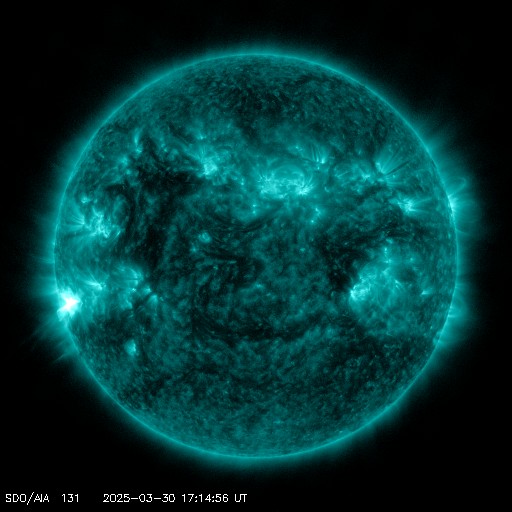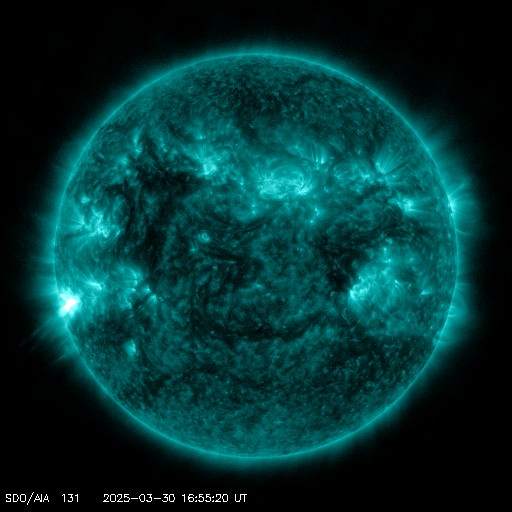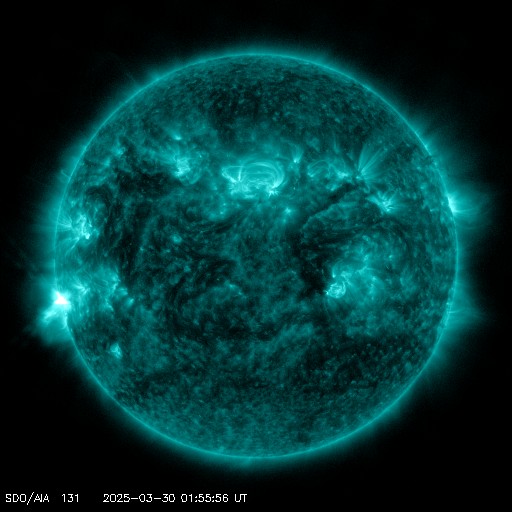Viewing archive of Sunday, 27 May 2012
Solar activity report
Any mentioned solar flare in this report has a scaling factor applied by the Space Weather Prediction Center (SWPC). Because of the SWPC scaling factor, solar flares are reported as 42% smaller than for the science quality data. The scaling factor has been removed from our archived solar flare data to reflect the true physical units.
Report of Solar-Geophysical Activity 2012 May 27 2200 UTCPrepared by the NOAA © SWPC and processed by SpaceWeatherLive.com
Joint USAF/NOAA Report of Solar and Geophysical Activity
SDF Number 148 Issued at 2200Z on 27 May 2012IA. Analysis of Solar Active Regions and Activity from 26-2100Z to 27-2100Z
Solar activity was low. Region 1492 produced a long
duration C-class flare at 27/0552Z. This event was associated with a
CME observed off the southeast limb of the solar disk in LASCO C2/C3
and does not appear to be earth directed. Another more impressive
CME was observed at the end of the period yesterday. No flare was
observed in conjunction due to a source from around the west limb.
However, type II and IV radio sweeps were observed from the event,
in addition to a later observed 10 MeV proton event (NOAA Scale S1).
The CME shock and driver cloud are observable in LASCO C2/C3 as a
backside asymmetric halo and are not expected to be geoeffective.
IB. Solar Activity Forecast
Solar activity is expected to be very
low to low for the next 3 days (28-30 May).
IIA. Geophysical Activity Summary 26-2100Z to 27-2100Z
The geomagnetic field was quiet. The greater than 10 MeV proton event
at geosynchronous orbit that began at 27/0535Z, reached a maximum of
14 pfu at 27/1045Z and ended at 27/1235Z. The greater than 2 MeV
electron flux at geosynchronous orbit reached high levels during the
period.
IIB. Geophysical Activity Forecast
The geomagnetic field is
expected to be mostly quiet for the next 3 days (28-30 May).
III. Event Probabilities 28 May to 30 May
| Class M | 05% | 05% | 05% |
| Class X | 01% | 01% | 01% |
| Proton | 01% | 01% | 01% |
| PCAF | green | ||
IV. Penticton 10.7 cm Flux
Observed 27 May 111 Predicted 28 May-30 May 110/110/110 90 Day Mean 27 May 117
V. Geomagnetic A Indices
Observed Afr/Ap 26 May 005/004 Estimated Afr/Ap 27 May 004/004 Predicted Afr/Ap 28 May-30 May 006/005-006/005-006/005
VI. Geomagnetic Activity Probabilities 28 May to 30 May
| A. Middle Latitudes | |||
|---|---|---|---|
| Active | 05% | 05% | 05% |
| Minor storm | 01% | 01% | 01% |
| Major-severe storm | 01% | 01% | 01% |
| B. High Latitudes | |||
|---|---|---|---|
| Active | 15% | 15% | 15% |
| Minor storm | 15% | 15% | 15% |
| Major-severe storm | 10% | 10% | 10% |
All times in UTC
Current data suggests there is a slight possibility for aurora to appear at the following high latitude regions in the near future
Norilsk, VorkutaLatest news
Latest forum messages
More topicsSupport SpaceWeatherLive.com!
A lot of people come to SpaceWeatherLive to follow the Sun's activity or if there is aurora to be seen, but with more traffic comes higher server costs. Consider a donation if you enjoy SpaceWeatherLive so we can keep the website online!

Latest alerts
17:27 UTC - Solar flare
Moderate M1.5 flare
17:03 UTC - Solar flare
Moderate M1.61 flare
16:45 UTC - Radio Blackout
Minor R1 radio blackout in progress (≥M1 - current: M1.61)
02:09 UTC - Solar flare
Moderate M1.54 flare from sunspot region 4048
01:42 UTC - Radio Blackout
Minor R1 radio blackout in progress (≥M1 - current: M1.24)
Space weather facts
| Last X-flare | 2025/03/28 | X1.1 |
| Last M-flare | 2025/03/30 | M1.4 |
| Last geomagnetic storm | 2025/03/27 | Kp5 (G1) |
| Spotless days | |
|---|---|
| Last spotless day | 2022/06/08 |
| Monthly mean Sunspot Number | |
|---|---|
| February 2025 | 154.6 +17.6 |
| March 2025 | 127.5 -27.1 |
| Last 30 days | 127.5 -24.7 |





